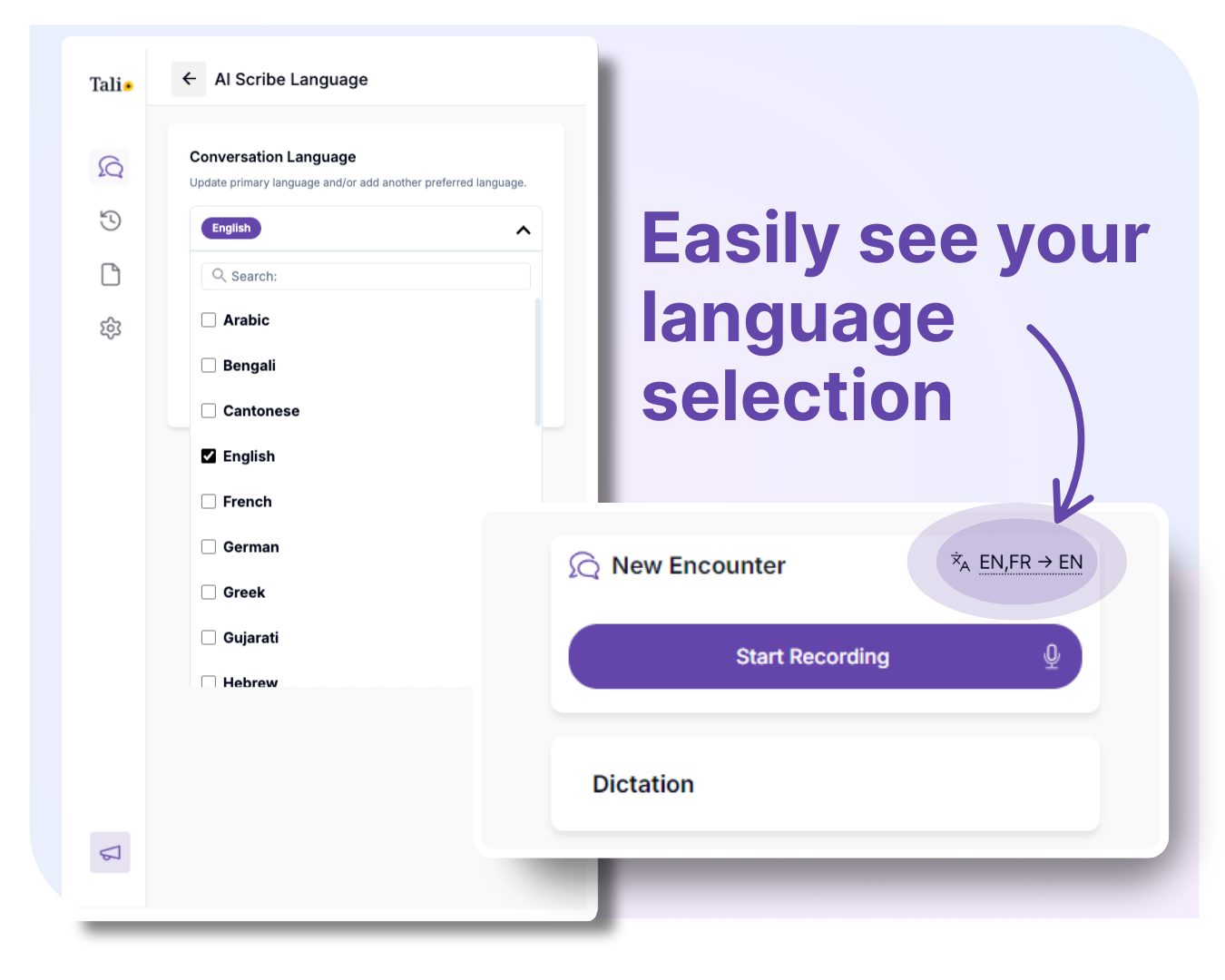Documentation and Administrative Tasks?
We’re proud to announce that Tali now supports documentation in 28 languages, including Spanish, Mandarin, Punjabi, Arabic, and Farsi, helping clinicians across Canada and the U.S. document patient visits more naturally and efficiently.
Already trusted by thousands of providers and selected by major EMRs including Practice Fusion, Med Access, CHR, Healthie, and VEHR, Tali makes multilingual scribing effortless, with industry-leading accuracy, no toggling mid-visit, and zero guesswork.
Canada is one of the most linguistically diverse countries in the world. According to Statistics Canada, nearly 1 in 3 Canadians speak a non-official language. Spanish is the most spoken non-official language, followed by Mandarin, Punjabi, and Arabic.
In the U.S., that linguistic diversity is just as present. From Spanish-speaking communities in California and Texas to Arabic-speaking patients in Michigan and French speakers in Louisiana, multilingual care is the norm, not the exception.
At Tali, we believe clinicians should be able to document patient visits in the language they actually happen in, whether that’s English, Farsi, or Punjabi.
“Multilingual support has always been on our roadmap, but we knew it needed to be done right. This update reflects the real-world experience of clinicians across North America.”
— Mahshid Yassaei, CEO of Tali AI
Some scribe tools offer long lists of languages. Others promise auto-detection or translation. But more options don’t always mean better care.
With Tali, we focused on doing multilingual right:
✅ Up to two spoken languages, set once (no mid-visit switching)
✅ Designed for speed, no extra clicks or toggles to slow you down
✅ Built for accuracy, because guessing wrong isn’t good enough in healthcare
Unlike tools that try to auto-detect language or translate live, Tali prioritises accuracy and reliability, especially for clinical documentation where stakes are high.
Tali’s multilingual support includes the most commonly spoken languages across North America, including:
Arabic, Bengali, Cantonese, English, French, German, Greek, Gujarati, Hebrew, Hindi, Indonesian, Italian, Japanese, Korean, Mandarin, Persian (Farsi), Polish, Portuguese, Punjabi, Romanian, Russian, Spanish, Swahili, Tamil, Turkish, Ukrainian, Urdu, Vietnamese
French and Farsi support in Tali already outperform alternatives in accuracy and ease of use, especially compared to solutions that require premium upgrades just to unlock extra languages.
Tali is trusted by thousands of clinicians across Canada and the U.S., and selected by provincial and national health programs, including Canada Health Infoway and the OntarioMD AI Scribe Pilot. We’re PHIPA, PIPEDA, and SOC 2 Type 2 compliant, and we were ranked in the top 1% of AI scribes by the U.S. Department of Veterans Affairs.
Now, with expanded multilingual support, we’re deepening our commitment to inclusive, patient-centred care.
Why It Matters
This update isn’t just about speaking more languages. It’s about:
Empowering bilingual and multilingual care teams
Supporting patients in the languages they’re most comfortable with
Making accurate, AI-powered documentation available to everyone
When clinicians can document care in the language it’s delivered, patients win. So do clinics, communities, and our healthcare system as a whole.
Available Now
All Tali users can access this update by ensuring they’re on the latest version of the app, whether on web, desktop, or Chrome extension. - Mobile coming soon!
The old “Multilingual” setting will no longer be supported.
All users must now choose up to two spoken languages.
If you speak a language not selected, Tali won’t transcribe it correctly.
Because transcription happens after submission, if you don't change from Multilingual, you won’t see an error until it’s too late.
Open Tali on any platform
Go to Settings
Select Language
Choose up to two spoken languages
That’s it! You’ll only need to do this once

🔗 Start Free Trial
🔗 Talk to Sales
Got questions?
Our team is here for you.
Contact us at:
Or visit